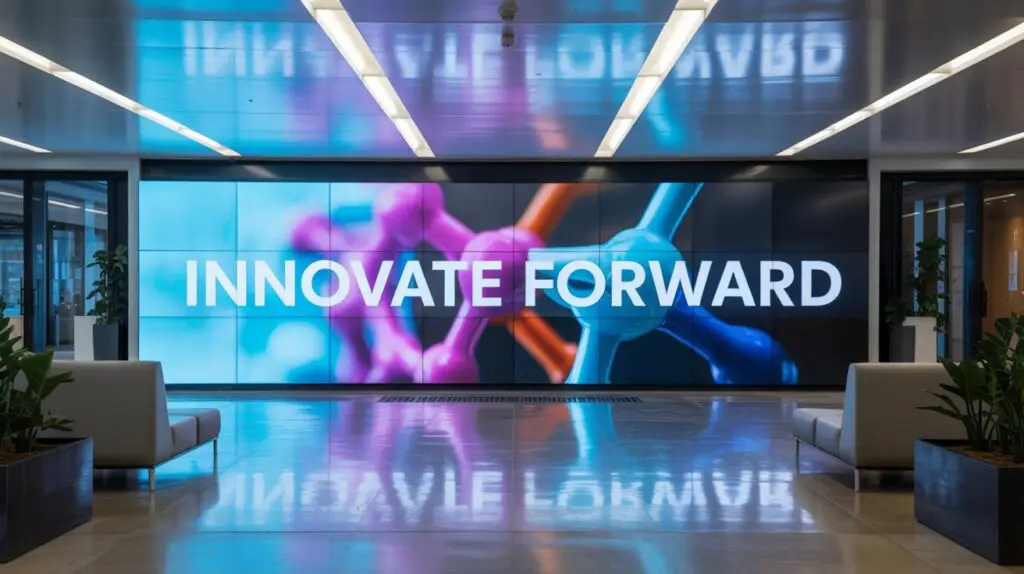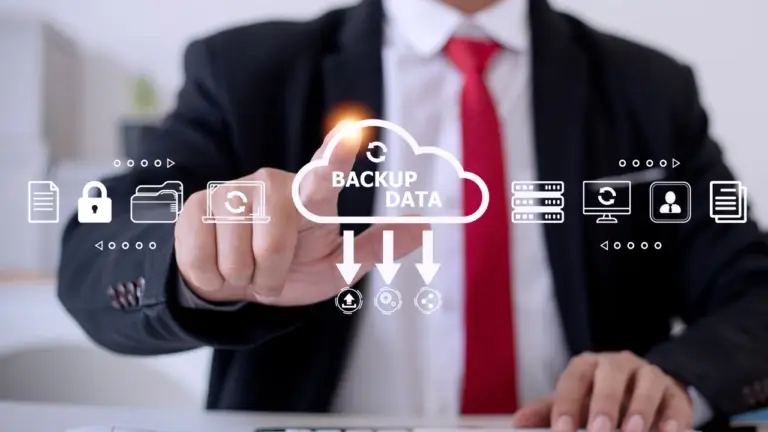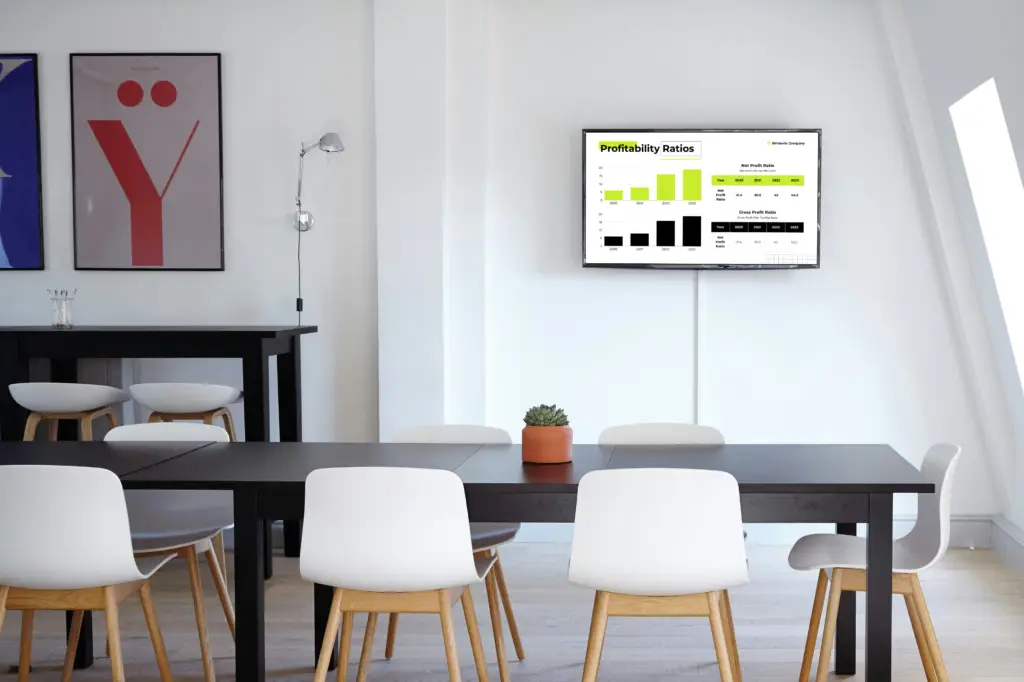Today’s offices need a better way to share information. Emails pile up. Important messages get missed. People stay out of the loop. Corporate digital signage fixes that.
When you place screens in key areas of your workplace, you can:
- Share news the moment it happens
- Show real-time data everyone can see
- Keep remote and in-office teams on the same page
- Make sure emergency alerts are seen fast
These screens connect with your existing tools. They show the right content to the right people at the right time. It’s like having a company news feed that’s always visible and easy to follow.
Why Invest in Corporate Digital Signage?
Digital signage isn’t just a fancy replacement for the old corkboard in the break room. When used right, it becomes a powerful communication tool. It helps companies stay connected, informed, and aligned.
Here’s what it really brings to the table:
Boosts Productivity Project timelines. Sales goals. Live KPIs. Put the numbers that matter where people can actually see them. No more hunting through dashboards or inboxes. Real-time updates on workplace screens keep everyone focused and in sync.
Drives Engagement A little recognition goes a long way. Use your screens to shout out birthdays, team wins, and company milestones. Highlight upcoming events or cross-team efforts. When employees feel seen, they stay connected and motivated.
Improves Communication Important message? No problem. Digital signage pushes key updates to every screen instantly. No email chains. No Slack overload. Just clear, visible information that reaches everyone, right when it counts.

Choosing Your Corporate Digital Signage Software
A strong digital signage strategy starts with the right software. The best platforms do more than display content. They connect with your existing tools. They protect your data. And they make it easy for any team to manage updates.
Here’s what to look for:
Ease of Use Your software should be simple enough for any department to manage. Non-technical users should be able to create, schedule, and update content. They shouldn’t need IT support or a training manual.
Integration Capabilities Look for platforms that integrate with the tools you already use. Things like Power BI, SharePoint, Slack, and Microsoft Teams. This ensures information displayed is always accurate and up-to-date.
Built-In Security Corporate content often includes sensitive information. Choose software that offers strong security features. Data encryption, multi-factor authentication, and SOC 2 compliance keep your network safe.
Scales With You Your digital signage should grow as your business does. Whether you’re adding new offices, teams, or screen types, the right software makes expansion easy. It shouldn’t require major changes.
Need Help With your Corporate Signage Project?
Key Integrations for Maximum Impact
Digital signage isn’t just for news tickers and welcome messages. When it connects with the tools your teams already use, it becomes powerful. It becomes a real-time, high-impact communication channel.
Here’s how it works with the platforms you rely on every day:
Power BI: Put Live Data Where People Can See It
Make your dashboards do more than sit in a browser tab.
Visibility that drives action Show real-time KPIs, project status, and performance metrics in shared spaces. Break rooms, sales floors, operations hubs. Places where people actually are.
Smarter, faster decisions When key data is always visible, teams can spot issues early. They respond quickly. They stay aligned without opening a single report.
SharePoint: Extend Internal Content Without Extra Steps
If your company uses SharePoint, don’t let that content live in a silo.
Keep everyone informed Automatically display updated policies, compliance reminders, or training links on digital signage screens. No mass emails needed.
Promote project progress Share key milestones, launches, or updates across departments. No extra work from HR or internal comms.
Slack and Teams: Take Messaging Beyond the Desktop
Not everyone is at their desk all day. Digital signage fills the gap.
Everyday awareness Show meeting reminders, deadlines, and events in hallways, lounges, and production areas. Everyone stays in the loop.
Real-time alerts Push critical IT updates or safety alerts to common-area screens instantly. Faster responses. Fewer missed messages.
Excel and PowerPoint: Make Familiar Tools More Powerful
You’re already building reports and decks. Now let them shine in public view.
Showcase your data Pull charts, forecasts, or financial dashboards directly from Excel. Put them on loop where they make an impact.
Broadcast announcements visually Recognition slides, event promos, and company updates from PowerPoint can hit the big screen. Zero redesign required.
The Bottom Line When your digital signage talks to your workplace tools, your screens stop being passive displays. They become smart, connected extensions of your company’s communication system.



Addressing Department-Specific Needs
Each department in your company has unique communication needs. With the right digital signage system, you can deliver the right message to the right people. No clutter. No confusion.
Customize Content by Department
Digital signage isn’t one-size-fits-all. When software allows for customization, every department can create content that supports its specific goals:
IT Share real-time system alerts, cybersecurity tips, and scheduled maintenance updates. Keep everyone informed about tech issues before they become disruptions.
HR Display onboarding content, training reminders, and employee recognition messages. Reinforce culture and communication at every stage of the employee journey.
Marketing and Sales Show live campaign data, sales numbers, and goal progress. Use screens to celebrate wins and keep teams aligned with real-time performance metrics.
Keep Control While Empowering Teams
A strong corporate digital signage strategy combines centralized management with departmental flexibility. Let teams manage their own content. But ensure brand consistency and message integrity across the organization.
IT and communications teams can oversee security and compliance. Departments get the freedom to speak directly to their teams.
Grow Without Outgrowing Your System
As your company expands, your signage should scale with it. Avoid free or entry-level solutions that can’t keep up. Choose a platform built for growth. One with the ability to:
- Add new departments and users
- Support more screens across more locations
- Handle diverse content formats with ease
Future-ready signage means fewer roadblocks and more impact. No matter how big your business becomes.

ROI Measurement for Corporate Digital Signage
Success isn’t just about screens staying online or playlists running smoothly. To truly understand the value of your digital signage, you need to track results. Both measurable results and meaningful change in your workplace.
Key Metrics That Show Real Progress
These data points reveal how signage improves communication, productivity, and engagement:
Employee Engagement Track participation in contests, surveys, or internal campaigns promoted through digital signage.
Information Retention Measure how well employees recall or act on messages displayed across your screens.
Emergency Response Times Monitor how quickly teams respond to critical alerts or system failures after messages appear on signage.
Fewer Internal Emails A noticeable drop in mass emails may signal more efficient communication through visual channels.
Better Meeting Attendance Punctuality and participation often improve when reminders are clearly displayed in high-traffic areas.
Benefits You Can’t Always Measure
Not everything can be tracked in a spreadsheet. When talking about digital signage for corporate communications, some of the most powerful outcomes are cultural:
Stronger Company Culture Recognizing birthdays, milestones, and employee shout-outs builds a workplace where people feel connected and appreciated.
More Collaboration Across Teams Sharing company-wide updates helps different departments stay aligned and informed.
Less Confusion, Fewer Delays When information is visible and clear, people spend less time asking questions. More time getting things done.
Happier, More Informed Employees Transparent communication makes people feel included and respected. This boosts morale across the board.
Book a free consultation today
Maintenance and Updates
Regular Maintenance Tasks
- Weekly content audits
- Monthly performance checks
- Quarterly security updates
- Annual hardware inspections
- Content relevancy reviews
System Health Monitoring
- Display uptime tracking
- Content delivery verification
- Network performance monitoring
- Security alert management
- User access audits
Security Essentials for Workplace Digital Signage
When your screens display internal updates, performance data, or employee information, security isn’t optional. It’s essential. Protecting sensitive content starts with choosing software that’s built for security from the ground up.
Here are the key features to look for:
Single Sign-On (SSO) and Multi-Factor Authentication (MFA) Make access simple for your team but impossible for outsiders. These tools streamline login while protecting your system from unauthorized users.
SOC 2 Compliance Choose software that meets rigorous standards for data security, availability, and confidentiality. This is especially important for industries like finance, healthcare, and legal where compliance is non-negotiable.
Data Encryption Your data should be protected at every step. Look for software that encrypts information both while it’s stored and while it’s being transmitted.
Regular Security Audits Cyber threats don’t sit still. Routine security audits help you stay one step ahead. They uncover vulnerabilities before they become real problems.

Future Trends To Keep Track Of
Emerging Technologies
- AI-powered content optimization
- Interactive touchless displays
- Augmented reality integration
- Environmental sensors integration
- Personalized content delivery
Integration Opportunities
- Smart building systems
- Employee mobile apps
- Visitor management systems
- Emergency response systems
- Asset tracking solutions
Conclusion: Corporate Digital Signage for a Cohesive Workplace
Digital signage for corporate communications is changing how companies communicate internally. When done right, it:
- Gets important messages to everyone quickly
- Makes information easy to see and understand
- Keeps office and remote workers connected
- Protects sensitive company information
Want to get started? Talk to a digital signage expert first. They can help you choose software that works with your current tools and meets your company’s needs. This will save you time and help you avoid common mistakes.
The right digital signage system does more than just share information. It brings your workplace together and helps everyone do their best work.
Learn more in my full Corporate Digital Signage insights archive
FAQ
What is corporate digital signage used for?
Digital signage is used to improve internal communication, boost employee engagement, and streamline real-time updates across offices. It’s perfect for sharing KPIs, event info, HR messages, and branded content in lobbies, break rooms, and conference areas.
Is digital signage secure enough for corporate environments?
Yes, when configured properly. Modern digital signage platforms offer enterprise-grade security with encrypted content delivery, user access controls, and network segmentation. I always recommend pairing your signage with your IT team’s security protocols to keep things locked down.
How do I know if my office is ready for digital signage?
If your team relies on email or posters to share updates, you’re ready. All you need is a screen, Wi-Fi, and a simple content strategy. I help clients audit their space, choose the right tech, and launch without turning it into an IT nightmare.


